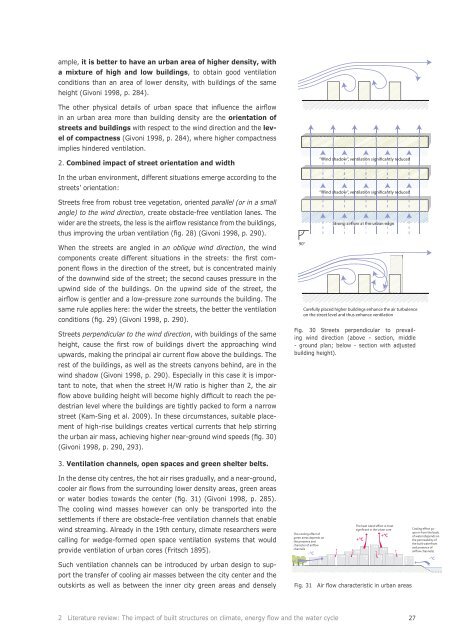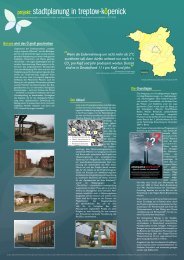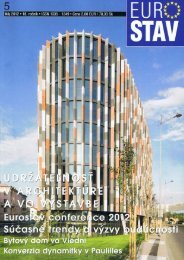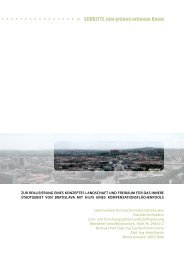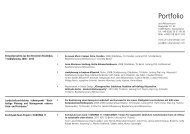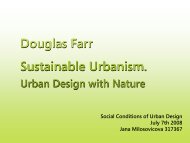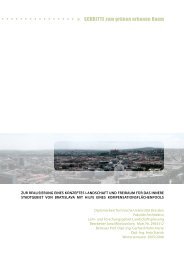Thesis document - Jana Milosovicova - Urban Design English
Thesis document - Jana Milosovicova - Urban Design English
Thesis document - Jana Milosovicova - Urban Design English
- No tags were found...
Create successful ePaper yourself
Turn your PDF publications into a flip-book with our unique Google optimized e-Paper software.
ample, it is better to have an urban area of higher density, witha mixture of high and low buildings, to obtain good ventilationconditions than an area of lower density, with buildings of the sameheight (Givoni 1998, p. 284).The other physical details of urban space that influence the airflowin an urban area more than building density are the orientation ofstreets and buildings with respect to the wind direction and the levelof compactness (Givoni 1998, p. 284), where higher compactnessimplies hindered ventilation.2. Combined impact of street orientation and widthIn the urban environment, different situations emerge according to thestreets’ orientation:Streets free from robust tree vegetation, oriented parallel (or in a smallangle) to the wind direction, create obstacle-free ventilation lanes. Thewider are the streets, the less is the airflow resistance from the buildings,thus improving the urban ventilation (fig. 28) (Givoni 1998, p. 290).When the streets are angled in an oblique wind direction, the windcomponents create different situations in the streets: the first componentflows in the direction of the street, but is concentrated mainlyof the downwind side of the street; the second causes pressure in theupwind side of the buildings. On the upwind side of the street, theairflow is gentler and a low-pressure zone surrounds the building. Thesame rule applies here: the wider the streets, the better the ventilationconditions (fig. 29) (Givoni 1998, p. 290).Streets perpendicular to the wind direction, with buildings of the sameheight, cause the first row of buildings divert the approaching windupwards, making the principal air current flow above the buildings. Therest of the buildings, as well as the streets canyons behind, are in thewind shadow (Givoni 1998, p. 290). Especially in this case it is importantto note, that when the street H/W ratio is higher than 2, the airflow above building height will become highly difficult to reach the pedestrianlevel where the buildings are tightly packed to form a narrowstreet (Kam-Sing et al. 2009). In these circumstances, suitable placementof high-rise buildings creates vertical currents that help stirringthe urban air mass, achieving higher near-ground wind speeds (fig. 30)(Givoni 1998, p. 290, 293).90°“Wind shadow”, ventilation significantly reduced“Wind shadow”, ventilation significantly reducedStrong airflow at the urban edgeCarefully placed higher buildings enhance the air turbulenceon the street level and thus enhance ventilationFig. 30 Streets perpendicular to prevailingwind direction (above - section, middle- ground plan; below - section with adjustedbuilding height).3. Ventilation channels, open spaces and green shelter belts.In the dense city centres, the hot air rises gradually, and a near-ground,cooler air flows from the surrounding lower density areas, green areasor water bodies towards the center (fig. 31) (Givoni 1998, p. 285).The cooling wind masses however can only be transported into thesettlements if there are obstacle-free ventilation channels that enablewind streaming. Already in the 19th century, climate researchers werecalling for wedge-formed open space ventilation systems that wouldprovide ventilation of urban cores (Fritsch 1895).Such ventilation channels can be introduced by urban design to supportthe transfer of cooling air masses between the city center and theoutskirts as well as between the inner city green areas and denselyThe cooling effect ofgreen areas depends onthe presence andcharacter of airflowchannels-°CThe heat island effect is mostsignificant in the urban core+°C+°CFig. 31 Air flow characteristic in urban areasCooling effect 50 -300 m from the bodyof water (depends onthe permeability ofthe built waterfrontand presence ofairflow channels)-°C2 Literature review: The impact of built structures on climate, energy flow and the water cycle27


